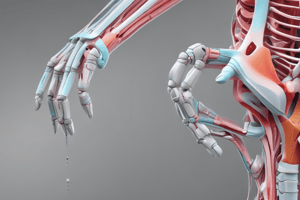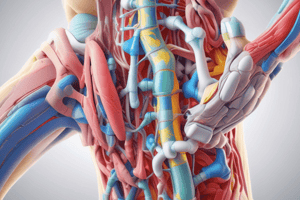Podcast
Questions and Answers
Arthrology is the study of the classification, structure, and function of muscles.
Arthrology is the study of the classification, structure, and function of muscles.
False (B)
Understanding the classification, structure, and function of joints is not important in the study of kinesiology.
Understanding the classification, structure, and function of joints is not important in the study of kinesiology.
False (B)
Detailed information about joint impairments is not required for effective rehabilitation of persons with joint dysfunction.
Detailed information about joint impairments is not required for effective rehabilitation of persons with joint dysfunction.
False (B)
Joint design and material selection are solely based on the function of the joint.
Joint design and material selection are solely based on the function of the joint.
Joints designed for stability will have the same design as those designed for mobility.
Joints designed for stability will have the same design as those designed for mobility.
The complexity of joint design increases as functional demands decrease.
The complexity of joint design increases as functional demands decrease.
Synarthroses joints allow significant movement between bones.
Synarthroses joints allow significant movement between bones.
Arthrokinematics and osteokinematics are key objectives in the study of joint function.
Arthrokinematics and osteokinematics are key objectives in the study of joint function.
Passive ROM involves the maximum force exerted by the flexors at the end range of motion.
Passive ROM involves the maximum force exerted by the flexors at the end range of motion.
Degrees of freedom in anatomy refer to the number of independent movements allowed at a joint.
Degrees of freedom in anatomy refer to the number of independent movements allowed at a joint.
During an impure swing in osteokinematics, the movement is restricted to back and forth rotation around a fixed pivot point.
During an impure swing in osteokinematics, the movement is restricted to back and forth rotation around a fixed pivot point.
Side-to-side translation is an example of angular motion in osteokinematics.
Side-to-side translation is an example of angular motion in osteokinematics.
External force applied by a therapist can be used to assess the amount of maximal joint play.
External force applied by a therapist can be used to assess the amount of maximal joint play.
The physiological barrier in anatomy refers to the middle range of motion.
The physiological barrier in anatomy refers to the middle range of motion.
Spin in osteokinematics involves rotation around a joint axis.
Spin in osteokinematics involves rotation around a joint axis.
The loose-packed position provides more natural structural stability compared to the resting position.
The loose-packed position provides more natural structural stability compared to the resting position.
A saddle joint has paired convex and convex surfaces oriented at ~90° to each other.
A saddle joint has paired convex and convex surfaces oriented at ~90° to each other.
Synovial fluid is always associated with diarthrodial joints.
Synovial fluid is always associated with diarthrodial joints.
Articular capsule is part of the elements always associated with joints.
Articular capsule is part of the elements always associated with joints.
Blood vessels are sometimes associated with diarthrodial joints.
Blood vessels are sometimes associated with diarthrodial joints.
Osteokinematics describes the motion of bones relative to the three cardinal planes of the body.
Osteokinematics describes the motion of bones relative to the three cardinal planes of the body.
Joint play is required to ensure articular surfaces can slide freely in the direction of desired movement.
Joint play is required to ensure articular surfaces can slide freely in the direction of desired movement.
Intraarticular discs are always associated with diarthrodial joints.
Intraarticular discs are always associated with diarthrodial joints.
Synovial plicae decrease the synovial surface area of joints.
Synovial plicae decrease the synovial surface area of joints.
Soft tissue approximation is the end feel for elbow extension.
Soft tissue approximation is the end feel for elbow extension.
Muscle spasm is considered a normal end feel during joint examination.
Muscle spasm is considered a normal end feel during joint examination.
Type I collagen fibers compose ligaments, tendons, and fibrocartilage.
Type I collagen fibers compose ligaments, tendons, and fibrocartilage.
Spasticity is associated with damage to lower motor neurons.
Spasticity is associated with damage to lower motor neurons.
Empty end feel is a normal end feel during passive range of motion testing.
Empty end feel is a normal end feel during passive range of motion testing.
The concept of kinematic chains is useful for analyzing human motion only.
The concept of kinematic chains is useful for analyzing human motion only.
Ground substance is one of the biologic materials that form periarticular connective tissues.
Ground substance is one of the biologic materials that form periarticular connective tissues.
Tissue stretch is the end feel for finger extension.
Tissue stretch is the end feel for finger extension.
Type II fibers are thicker and stiffer than type I fibers.
Type II fibers are thicker and stiffer than type I fibers.
Elastin fibers provide a flexible woven framework for maintaining the shape of structures like hyaline cartilage.
Elastin fibers provide a flexible woven framework for maintaining the shape of structures like hyaline cartilage.
Tissues with a high proportion of elastin struggle to return to their original shape.
Tissues with a high proportion of elastin struggle to return to their original shape.
Collagen and elastin fibers are embedded in a dry matrix known as ground substance.
Collagen and elastin fibers are embedded in a dry matrix known as ground substance.
Glycosaminoglycans (GAGs) are positively charged and repel water.
Glycosaminoglycans (GAGs) are positively charged and repel water.
Water assists in the diffusion of nutrients within the tissue.
Water assists in the diffusion of nutrients within the tissue.
Cells in periarticular connective tissues do not synthesize specialized ground substance and fibrous proteins unique to the tissue.
Cells in periarticular connective tissues do not synthesize specialized ground substance and fibrous proteins unique to the tissue.
Cells in periarticular connective tissues confer significant mechanical properties on the tissue, similar to skeletal muscle cells.
Cells in periarticular connective tissues confer significant mechanical properties on the tissue, similar to skeletal muscle cells.
Flashcards
Type II fibers
Type II fibers
Thinner and less stiff than type I fibers, providing a flexible woven framework for maintaining shape and consistency of structures like hyaline cartilage.
Elastin fibers
Elastin fibers
Netlike interweaving of small fibrils, allowing for flexible and elastic properties. These fibers are found in tissues that need to stretch and recoil, like ligaments and blood vessels.
Ground substance
Ground substance
Matrix or gel-like substance surrounding cells and fibers in connective tissues. It's responsible for providing support, lubrication, and nutrient diffusion.
Glycosaminoglycans (GAGs)
Glycosaminoglycans (GAGs)
Signup and view all the flashcards
Cells in Connective Tissues
Cells in Connective Tissues
Signup and view all the flashcards
Osteokinematics
Osteokinematics
Signup and view all the flashcards
Arthrokinematics
Arthrokinematics
Signup and view all the flashcards
Synarthroses
Synarthroses
Signup and view all the flashcards
Spin
Spin
Signup and view all the flashcards
Swing
Swing
Signup and view all the flashcards
Pure swing
Pure swing
Signup and view all the flashcards
Impure swing
Impure swing
Signup and view all the flashcards
Degree of freedom (DOF)
Degree of freedom (DOF)
Signup and view all the flashcards
Active ROM
Active ROM
Signup and view all the flashcards
Passive ROM
Passive ROM
Signup and view all the flashcards
End feel
End feel
Signup and view all the flashcards
Ovoid joint
Ovoid joint
Signup and view all the flashcards
Saddle joint
Saddle joint
Signup and view all the flashcards
Synovial fluid
Synovial fluid
Signup and view all the flashcards
Articular cartilage
Articular cartilage
Signup and view all the flashcards
Articular capsule
Articular capsule
Signup and view all the flashcards
Synovial membrane
Synovial membrane
Signup and view all the flashcards
Ligaments
Ligaments
Signup and view all the flashcards
Blood vessels in synovial joints
Blood vessels in synovial joints
Signup and view all the flashcards
Sensory nerves in synovial joints
Sensory nerves in synovial joints
Signup and view all the flashcards
Osteokinematics (joint kinematics)
Osteokinematics (joint kinematics)
Signup and view all the flashcards
Arthrokinematics (joint kinematics)
Arthrokinematics (joint kinematics)
Signup and view all the flashcards
Axial translatory forces (normal forces)
Axial translatory forces (normal forces)
Signup and view all the flashcards
Compression
Compression
Signup and view all the flashcards
Tension/traction
Tension/traction
Signup and view all the flashcards
Joint play
Joint play
Signup and view all the flashcards
Study Notes
Biologic Materials that form Periarticular Connective Tissues
- Fibers/Fibrous Proteins:
- Type II fibers: thinner and less stiff than type I fibers, providing a flexible woven framework for maintaining shape and consistency of structures like hyaline cartilage
- Elastin fibers: netlike interweaving of small fibrils, allowing for flexible and elastic properties
- Elastin-rich tissues (e.g., hyaline or elastic cartilage and ligamentum flavum) return to their original shape after deformation
Ground Substance
- Matrix or gel-like substance surrounding cells and fibers
- Composed of glycosaminoglycans (GAGs): negatively charged polysaccharides attracting water, creating osmotic swelling pressure and swelling
- GAGs:
- Attract water, creating an osmotic swelling pressure
- Water provides a fluid medium for nutrient diffusion within tissues and assists mechanical properties
Cells
- Responsible for synthesizing specialized ground substance and fibrous proteins unique to the tissue
- Maintain and repair tissues, but do not confer significant mechanical properties
Joint Structure and Function
- Osteokinematics: studies the motion of bones relative to the three cardinal planes of the body
- Arthrokinematics: studies the motion between the articular surfaces of joints
- Joint design and materials depend on joint function and nature of components
Classification of Joints
- Synarthroses: junctions between bones with slight to essentially no movement
- Classification based on movement potential:
- Classification of joints based on movement potential
Joint Movement
- Osteokinematics:
- Spin: rotation around a bone's long axis
- Swing: rotation around a joint axis
- Pure swing: movement back and forth around a fixed pivot point in one plane (pendulum)
- Impure swing: secondary movement around another axis
- Degree of freedom (DOF):
- 3 translational motions (side-to-side, AP, and distraction/compression)
- 3 angular motions (side-to-side, AP, and rotation around vertical axis)
- Range of Motion (ROM):
- Active ROM
- Passive ROM
- End feel: sensation at the end of the ROM
Joint Function
- Ovoid joint (egg-shaped): articular surface of one bone is convex, and the other is concave
- Saddle joint: each member presents paired convex and concave surfaces oriented at ~90° to each other
- Elements of diarthrodial/synovial joints:
- Synovial fluid (reduces friction)
- Articular cartilage (covers)
- Articular capsule (encloses)
- Synovial membrane (inner layer)
- Ligaments (capsular or extracapsular)
- Blood vessels (synovial membrane)
- Sensory nerves (capsule)
Joint Kinematics
- Osteokinematics: describes bone motion relative to the three cardinal planes of the body
- Arthrokinematics: describes motion between articular surfaces of joints
- Kinetics: axial translatory forces (normal forces)
- Compression: moving closer to each other
- Tension/traction: distraction (moving away)
- Osteokinematics is based on arthrokinematics
- Joint play is essential for determining if articular surfaces are free to slide in the direction of the desired movement
Studying That Suits You
Use AI to generate personalized quizzes and flashcards to suit your learning preferences.




